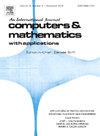Asynchronous multimodal PINN pre-train framework based on TransVNet(MPP-TV) and its application in numerical solutions of the Cauchy problem for the Hamilton-Jacobi equation
IF 2.9
2区 数学
Q1 MATHEMATICS, APPLIED
引用次数: 0
Abstract
The Hamilton-Jacobi(HJ) equation represents a class of highly nonlinear partial differential equations. Classical numerical techniques, such as finite element methods, face significant challenges when addressing the numerical solutions of such nonlinear HJ equations. However, recent advances in neural network-based approaches, particularly Physics-Informed Neural Networks (PINNs) and neural operator methods, have ushered in innovative paradigms for numerically solving HJ equations. In this work, we leverage the PINN approach, infused with the concept of neural operators. By encoding and extracting features from the discretized images of functions through TransVNet, which is a novel autoencoder architecture proposed in this paper, we seamlessly integrate Hamiltonian information into PINN training, thereby establishing a novel scientific computation framework. Additionally, we incorporate the vanishing viscosity method, introducing viscosity coefficients in our model, which equips our model to tackle potential singularities in nonlinear HJ equations. These attributes signify that our MPP-TV framework paves new avenues and insights for the generalized solutions of nonlinear HJ equations.

基于TransVNet的异步多模态PINN预训练框架(MPP-TV)及其在Hamilton-Jacobi方程Cauchy问题数值解中的应用
Hamilton-Jacobi(HJ)方程是一类高度非线性的偏微分方程。传统的数值方法,如有限元方法,在求解此类非线性HJ方程的数值解时面临着重大挑战。然而,基于神经网络的方法,特别是物理信息神经网络(pinn)和神经算子方法的最新进展,为数值求解HJ方程带来了创新的范式。在这项工作中,我们利用了PINN方法,注入了神经算子的概念。本文提出了一种新的自编码器架构TransVNet,通过对函数的离散图像进行编码和特征提取,将哈密顿信息无缝地融入到PINN训练中,从而建立了一种新的科学计算框架。此外,我们还引入了消失粘度法,在我们的模型中引入了粘度系数,使我们的模型能够处理非线性HJ方程的潜在奇异性。这些属性表明我们的MPP-TV框架为非线性HJ方程的广义解开辟了新的途径和见解。
本文章由计算机程序翻译,如有差异,请以英文原文为准。
求助全文
约1分钟内获得全文
求助全文
来源期刊

Computers & Mathematics with Applications
工程技术-计算机:跨学科应用
CiteScore
5.10
自引率
10.30%
发文量
396
审稿时长
9.9 weeks
期刊介绍:
Computers & Mathematics with Applications provides a medium of exchange for those engaged in fields contributing to building successful simulations for science and engineering using Partial Differential Equations (PDEs).
 求助内容:
求助内容: 应助结果提醒方式:
应助结果提醒方式:


